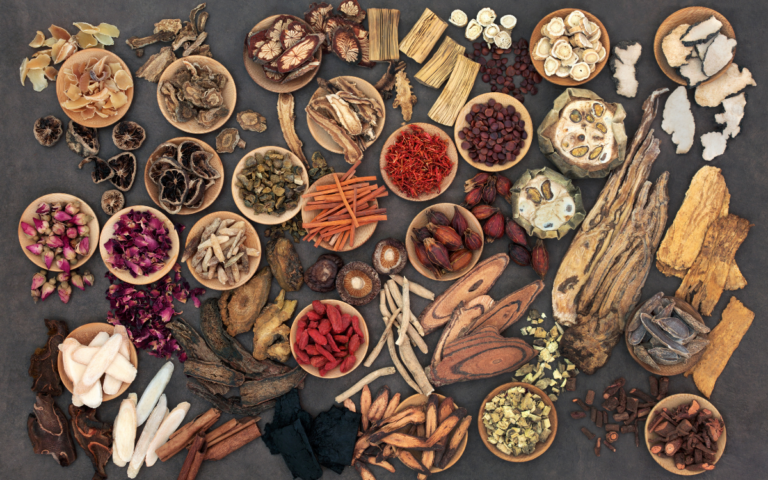Aphrodisiac herbs have been around for centuries, helping deepen connection and enhance sensation. They are used to enhance sexual desire, performance, and satisfaction. They work by improving physical and psychological factors such as blood circulation, hormone balance, energy levels, stress reduction, and emotional well-being, all of which can contribute to a healthy sexual experience.

aphrodisiacs spans thousands of years and reflects humanity’s enduring fascination with love, desire, and fertility. Named after Aphrodite, the Greek goddess of love and beauty, aphrodisiacs have been sought and celebrated in nearly every culture for their perceived ability to enhance sexual pleasure, arousal, and reproduction. Ancient civilizations have been using aphrodisiacs going all the way back to Mesopotamia. Early records from Mesopotamian tablets highlight the use of plants and potions to increase fertility and sexual vitality. Common ingredients included dates, honey, and herbs believed to boost libido. evidence from Ancient Egypt also shows Egyptians associated certain foods and substances with sensuality and fertility, such as figs, lettuce, and honey. Cleopatra herself was rumored to use perfumes and oils as love enhancers. in ancient and modern day india, plants are used to access vitality and life force energy. Ayurvedic texts like the Charaka Samhita mention numerous aphrodisiac herbs (e.g., Ashwagandha and Shatavari) as part of treatments for reproductive health and vitality and Tantra and Kama Sutra traditions also explored aphrodisiacs to enhance intimacy and pleasure. in TCM from Ancient China, Chinese medicine incorporated aphrodisiacs like Ginseng, Horny Goat Weed, and Deer Antler Velvet to support vitality, fertility, and sexual energy, aligning these with the balance of Qi (life force). The Greeks and Romans celebrated foods and herbs as aphrodisiacs, such as oysters, honey, and wine. Hippocrates and Galen wrote about the role of herbs like fennel and anise in stimulating desire. Aphrodite was mythologically tied to foods like pomegranates, symbolizing fertility and love. African cultures used roots, barks, and seeds such as Yohimbe and kola nuts as natural libido boosters and for ceremonial purposes related to fertility and marriage. During the Renaissance, aphrodisiacs became a mix of science, mysticism, and culinary art. Chocolate, exotic spices, and new discoveries from the Americas, such as vanilla, gained fame as love enhancers. Alchemists and physicians experimented with herbal tinctures and elixirs, blending plant medicine with emerging knowledge of human physiology.
How Aphrodisiac Herbs Work
Increasing Blood Flow: Some herbs improve circulation, which is essential for sexual function.
- Example: Ginseng improves blood flow to reproductive organs.
Balancing Hormones: Herbs that regulate hormones like testosterone and estrogen can boost libido.
- Example: Maca supports hormonal balance.
Reducing Stress and Anxiety: Many aphrodisiac herbs have adaptogenic properties, helping to reduce stress, which can hinder sexual desire.
- Example: Ashwagandha calms the mind and supports sexual vitality.
Boosting Energy and Vitality: Herbs that enhance stamina and vitality contribute to sexual health.
- Example: Tribulus terrestris enhances energy levels.
Enhancing Mood: Herbs that uplift mood and reduce fatigue can indirectly boost sexual interest.
- Example: Damiana is known for its mood-enhancing effects.
10 Common & Powerful Aphrodisiacs
Maca (Lepidium meyenii)
- Uses: Improves energy, stamina, libido, and hormonal balance for both men and women.
- Preparation: Taken as a powder in smoothies or capsules.
Ginseng (Panax ginseng)
- Uses: Enhances blood circulation, energy levels, and sexual performance.
- Preparation: Used as a tea, tincture, or capsule.
Ashwagandha (Withania somnifera)
- Uses: Reduces stress and boosts sexual stamina and reproductive health.
- Preparation: Taken as a powder, tea, or capsule.
Damiana (Turnera diffusa)
- Uses: Known for its ability to stimulate libido and reduce anxiety.
- Preparation: Brewed as a tea or used as a tincture.
Tribulus (Tribulus terrestris)
- Uses: Supports testosterone production and enhances libido.
- Preparation: Consumed as a capsule or extract.
Horny Goat Weed (Epimedium spp.)
- Uses: Boosts libido and addresses erectile dysfunction by improving circulation.
- Preparation: Taken as a tea, capsule, or extract.
Saffron (Crocus sativus)
- Uses: Enhances mood and sexual arousal; reduces stress-related libido issues.
- Preparation: Added to meals or consumed as a tea.
Catuaba (Erythroxylum catuaba)
- Uses: Traditionally used in South America to increase sexual desire and enhance performance.
- Preparation: Brewed as a tea or taken as a tincture.
Shatavari (Asparagus racemosus)
- Uses: Balances female hormones, boosts fertility, and enhances sexual desire.
- Preparation: Often consumed as a powder, tea, or capsule.
Muira Puama (Ptychopetalum olacoides)
- Uses: Known as “potency wood,” it improves libido and sexual performance in both men and women.
- Preparation: Used as a tea, tincture, or extract.

